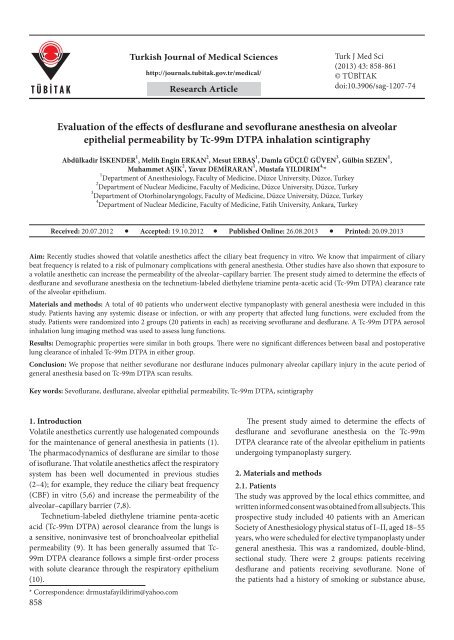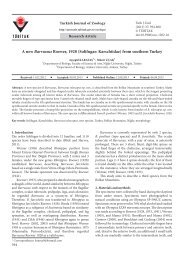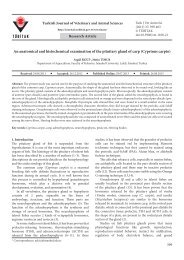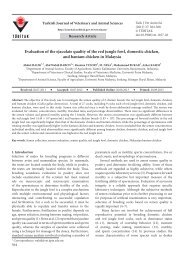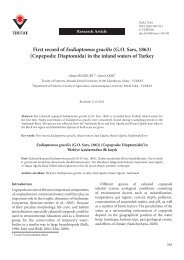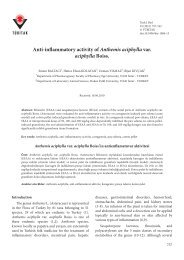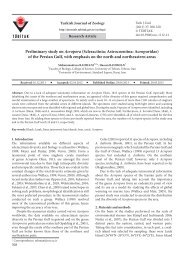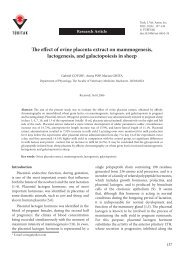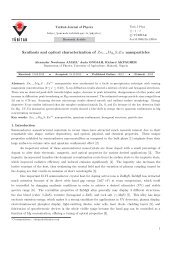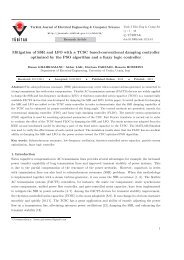Evaluation of the effects of desflurane and sevoflurane ... - Tübitak
Evaluation of the effects of desflurane and sevoflurane ... - Tübitak
Evaluation of the effects of desflurane and sevoflurane ... - Tübitak
Create successful ePaper yourself
Turn your PDF publications into a flip-book with our unique Google optimized e-Paper software.
Turkish Journal <strong>of</strong> Medical Sciences<br />
http://journals.tubitak.gov.tr/medical/<br />
Research Article<br />
Turk J Med Sci<br />
(2013) 43: 858-861<br />
© TÜBİTAK<br />
doi:10.3906/sag-1207-74<br />
<strong>Evaluation</strong> <strong>of</strong> <strong>the</strong> <strong>effects</strong> <strong>of</strong> <strong>desflurane</strong> <strong>and</strong> sev<strong>of</strong>lurane anes<strong>the</strong>sia on alveolar<br />
epi<strong>the</strong>lial permeability by Tc-99m DTPA inhalation scintigraphy<br />
Abdülkadir İSKENDER 1 , Melih Engin ERKAN 2 , Mesut ERBAŞ 1 , Damla GÜÇLÜ GÜVEN 3 , Gülbin SEZEN 1 ,<br />
Muhammet AŞIK 2 , Yavuz DEMİRARAN 1 , Mustafa YILDIRIM 4, *<br />
1<br />
Department <strong>of</strong> Anes<strong>the</strong>siology, Faculty <strong>of</strong> Medicine, Düzce University, Düzce, Turkey<br />
2<br />
Department <strong>of</strong> Nuclear Medicine, Faculty <strong>of</strong> Medicine, Düzce University, Düzce, Turkey<br />
3<br />
Department <strong>of</strong> Otorhinolaryngology, Faculty <strong>of</strong> Medicine, Düzce University, Düzce, Turkey<br />
4<br />
Department <strong>of</strong> Nuclear Medicine, Faculty <strong>of</strong> Medicine, Fatih University, Ankara, Turkey<br />
Received: 20.07.2012 Accepted: 19.10.2012 Published Online: 26.08.2013 Printed: 20.09.2013<br />
Aim: Recently studies showed that volatile anes<strong>the</strong>tics affect <strong>the</strong> ciliary beat frequency in vitro. We know that impairment <strong>of</strong> ciliary<br />
beat frequency is related to a risk <strong>of</strong> pulmonary complications with general anes<strong>the</strong>sia. O<strong>the</strong>r studies have also shown that exposure to<br />
a volatile anes<strong>the</strong>tic can increase <strong>the</strong> permeability <strong>of</strong> <strong>the</strong> alveolar–capillary barrier. The present study aimed to determine <strong>the</strong> <strong>effects</strong> <strong>of</strong><br />
<strong>desflurane</strong> <strong>and</strong> sev<strong>of</strong>lurane anes<strong>the</strong>sia on <strong>the</strong> technetium-labeled diethylene triamine penta-acetic acid (Tc-99m DTPA) clearance rate<br />
<strong>of</strong> <strong>the</strong> alveolar epi<strong>the</strong>lium.<br />
Materials <strong>and</strong> methods: A total <strong>of</strong> 40 patients who underwent elective tympanoplasty with general anes<strong>the</strong>sia were included in this<br />
study. Patients having any systemic disease or infection, or with any property that affected lung functions, were excluded from <strong>the</strong><br />
study. Patients were r<strong>and</strong>omized into 2 groups (20 patients in each) as receiving sev<strong>of</strong>lurane <strong>and</strong> <strong>desflurane</strong>. A Tc-99m DTPA aerosol<br />
inhalation lung imaging method was used to assess lung functions.<br />
Results: Demographic properties were similar in both groups. There were no significant differences between basal <strong>and</strong> postoperative<br />
lung clearance <strong>of</strong> inhaled Tc-99m DTPA in ei<strong>the</strong>r group.<br />
Conclusion: We propose that nei<strong>the</strong>r sev<strong>of</strong>lurane nor <strong>desflurane</strong> induces pulmonary alveolar capillary injury in <strong>the</strong> acute period <strong>of</strong><br />
general anes<strong>the</strong>sia based on Tc-99m DTPA scan results.<br />
Key words: Sev<strong>of</strong>lurane, <strong>desflurane</strong>, alveolar epi<strong>the</strong>lial permeability, Tc-99m DTPA, scintigraphy<br />
1. Introduction<br />
Volatile anes<strong>the</strong>tics currently use halogenated compounds<br />
for <strong>the</strong> maintenance <strong>of</strong> general anes<strong>the</strong>sia in patients (1).<br />
The pharmacodynamics <strong>of</strong> <strong>desflurane</strong> are similar to those<br />
<strong>of</strong> is<strong>of</strong>lurane. That volatile anes<strong>the</strong>tics affect <strong>the</strong> respiratory<br />
system has been well documented in previous studies<br />
(2–4); for example, <strong>the</strong>y reduce <strong>the</strong> ciliary beat frequency<br />
(CBF) in vitro (5,6) <strong>and</strong> increase <strong>the</strong> permeability <strong>of</strong> <strong>the</strong><br />
alveolar–capillary barrier (7,8).<br />
Technetium-labeled diethylene triamine penta-acetic<br />
acid (Tc-99m DTPA) aerosol clearance from <strong>the</strong> lungs is<br />
a sensitive, noninvasive test <strong>of</strong> bronchoalveolar epi<strong>the</strong>lial<br />
permeability (9). It has been generally assumed that Tc-<br />
99m DTPA clearance follows a simple first-order process<br />
with solute clearance through <strong>the</strong> respiratory epi<strong>the</strong>lium<br />
(10).<br />
* Correspondence: drmustafayildirim@yahoo.com<br />
858<br />
The present study aimed to determine <strong>the</strong> <strong>effects</strong> <strong>of</strong><br />
<strong>desflurane</strong> <strong>and</strong> sev<strong>of</strong>lurane anes<strong>the</strong>sia on <strong>the</strong> Tc-99m<br />
DTPA clearance rate <strong>of</strong> <strong>the</strong> alveolar epi<strong>the</strong>lium in patients<br />
undergoing tympanoplasty surgery.<br />
2. Materials <strong>and</strong> methods<br />
2.1. Patients<br />
The study was approved by <strong>the</strong> local ethics committee, <strong>and</strong><br />
written informed consent was obtained from all subjects. This<br />
prospective study included 40 patients with an American<br />
Society <strong>of</strong> Anes<strong>the</strong>siology physical status <strong>of</strong> I–II, aged 18–55<br />
years, who were scheduled for elective tympanoplasty under<br />
general anes<strong>the</strong>sia. This was a r<strong>and</strong>omized, double-blind,<br />
sectional study. There were 2 groups: patients receiving<br />
<strong>desflurane</strong> <strong>and</strong> patients receiving sev<strong>of</strong>lurane. None <strong>of</strong><br />
<strong>the</strong> patients had a history <strong>of</strong> smoking or substance abuse,
İSKENDER et al. / Turk J Med Sci<br />
or ongoing viral <strong>and</strong> bacterial lung infections. Their chest<br />
X-rays were normal. Exclusion criteria were <strong>the</strong> presence<br />
<strong>of</strong> cardiopulmonary, renal, hepatic, <strong>and</strong> any o<strong>the</strong>r systemic<br />
diseases, <strong>and</strong> employment in any occupation that may<br />
affect <strong>the</strong> pulmonary system. Pregnant women were also<br />
excluded. The patients were r<strong>and</strong>omly split into 2 groups.<br />
A computer-generated r<strong>and</strong>omized list was used to assign<br />
patients to 1 <strong>of</strong> 2 groups. Nei<strong>the</strong>r patients nor <strong>the</strong> nuclear<br />
medicine physician were informed as to which volatile<br />
anes<strong>the</strong>tic was used. On arrival to <strong>the</strong> anes<strong>the</strong>tics room, a<br />
vein was cannulated, arterial blood pressure was measured<br />
with an automated oscillometer, <strong>and</strong> monitoring <strong>of</strong> arterial<br />
oxygen saturation <strong>and</strong> electrocardiogram commenced.<br />
Anes<strong>the</strong>sia was induced with 1–2 µg/kg fentanyl, 0.6 mg/kg<br />
rocuronium, <strong>and</strong> 1–3 mg/kg prop<strong>of</strong>ol <strong>and</strong> maintained with<br />
66% nitrous oxide in oxygen; patients in <strong>the</strong> first group were<br />
given 2% sev<strong>of</strong>lurane, while <strong>the</strong> second group <strong>of</strong> patients<br />
received 6% <strong>desflurane</strong>.<br />
2.2. Tc-99m DTPA aerosol inhalation lung imaging<br />
Tc-99m DTPA radioaerosol inhalation lung scans were<br />
performed on all patients, 1 day before <strong>the</strong> operation <strong>and</strong><br />
24 h after <strong>the</strong> end <strong>of</strong> anes<strong>the</strong>sia. Tc-99m DTPA (MON.<br />
DTPA.KIT, MONROL, Turkey) solution <strong>of</strong> 1480 MBq (40<br />
mCi) was placed into <strong>the</strong> reservoir <strong>of</strong> a nebulizer system<br />
(VENTI-SCAN BIODEX III, USA). The mass median<br />
aerodynamic diameter <strong>of</strong> <strong>the</strong> Tc-99m DTPA radioaerosol<br />
was smaller than 1 µm, with an oxygen air flow rate <strong>of</strong> 7 L/<br />
min. All <strong>of</strong> <strong>the</strong> subjects were studied in <strong>the</strong> supine position<br />
<strong>and</strong> inhaled for 2 min from <strong>the</strong> aerosol delivery unit<br />
until <strong>the</strong> total radioactivity was over 200,000 counts by<br />
normal tidal breathing. Immediately after <strong>the</strong> inhalation,<br />
scintigraphic data were recorded dynamically (1 frame/<br />
min) in a posterior projection on a 64 × 64 matrix for<br />
30 min using a single-head gamma camera (Siemens<br />
E.CAM), which included a low-energy, high-resolution<br />
collimator. Regions <strong>of</strong> interest (ROIs) were drawn around<br />
<strong>the</strong> periphery <strong>of</strong> <strong>the</strong> right lung <strong>and</strong> on <strong>the</strong> major airways<br />
on <strong>the</strong> first-minute image. To obtain a pure alveolar ROI<br />
<strong>and</strong> to exclude <strong>the</strong> entire bronchial activity, <strong>the</strong> outer third<br />
<strong>of</strong> each lung was used as a peripheral lung region. The<br />
inner two-thirds <strong>of</strong> <strong>the</strong> lungs were defined as <strong>the</strong> central<br />
lung region. The brightness <strong>of</strong> <strong>the</strong> image was increased<br />
to visualize body background <strong>and</strong> <strong>the</strong> lung periphery to<br />
obtain <strong>the</strong> correct peripheral ROI. Time-activity curves<br />
were generated from <strong>the</strong> right lung <strong>of</strong> all subjects <strong>and</strong><br />
percent clearance <strong>of</strong> radioaerosol in 30 min was obtained.<br />
Clearance half-time, T1/2, was calculated by placing a<br />
monoexponential fit on <strong>the</strong> curves (Figure 1). Penetration<br />
index (PI) was also calculated by dividing <strong>the</strong> peripheral<br />
total counts by <strong>the</strong> sum <strong>of</strong> <strong>the</strong> peripheral <strong>and</strong> central total<br />
counts on <strong>the</strong> first-minute image in order to quantify <strong>the</strong><br />
distribution <strong>of</strong> <strong>the</strong> inhaled radioaerosol.<br />
2.3. Statistical analysis<br />
The α-value was set to 0.05 <strong>and</strong> power was accepted as<br />
0.90. We used <strong>the</strong> clearance half-time <strong>of</strong> <strong>the</strong> Tc-99m<br />
DTPA <strong>of</strong> alveolar epi<strong>the</strong>lial permeability for <strong>the</strong> primary<br />
end-point when calculating <strong>the</strong> sample size for our study.<br />
St<strong>and</strong>ardized effect size was calculated as 0.90 by using <strong>the</strong><br />
parameters <strong>of</strong> a previous report (11). Finally, <strong>the</strong> required<br />
sample size was calculated as 15 patients in each group.<br />
Statistical analyses were performed using SPSS 12 for<br />
Windows (SPSS Inc., Chicago, IL, USA) <strong>and</strong> a P-value <strong>of</strong><br />
less than 0.05 was considered as statistically significant.<br />
Frequencies (%) <strong>of</strong> sex in each group were defined with<br />
a chi-square test. Normal distributions <strong>of</strong> continuous<br />
variables were analyzed with <strong>the</strong> Shapiro–Wilk test. The<br />
Mann–Whitney U test was used for comparing median<br />
ages among groups. Pre- <strong>and</strong> postoperative differences<br />
in clearance half-time (T1/2 min) <strong>and</strong> PI were analyzed<br />
using <strong>the</strong> Wilcoxon sign test in each group. Durations <strong>of</strong><br />
anes<strong>the</strong>sia <strong>and</strong> operations within groups were analyzed<br />
with an independent samples t-test. Repeated-measures<br />
analysis <strong>of</strong> variance was used to evaluate mean arterial<br />
blood pressures changes in each group.<br />
Figure 1. A) To obtain a pure alveolar ROI <strong>and</strong> to exclude <strong>the</strong> entire bronchial activity, <strong>the</strong> outer third <strong>of</strong> <strong>the</strong> right lung was used.<br />
B) Time-activity curves were generated <strong>and</strong> percentage clearance <strong>of</strong> radioaerosol in 30 min was obtained. Clearance half-time T1/2<br />
(min) was calculated by placing a monoexponential fit (intermittent line) on <strong>the</strong> curves.<br />
859
İSKENDER et al. / Turk J Med Sci<br />
3. Results<br />
There were 20 patients [5 females, 15 males, mean age <strong>of</strong><br />
30 (range: 20–62) years] in <strong>the</strong> sev<strong>of</strong>lurane group <strong>and</strong> 20<br />
patients [9 females, 11 males, mean age <strong>of</strong> 32 (range: 19–42)<br />
years] in <strong>the</strong> <strong>desflurane</strong> group. The age range was similar in<br />
both groups. In sev<strong>of</strong>lurane patients, <strong>the</strong> median clearance<br />
half time (T1/2 min) <strong>of</strong> Tc-99m DTPA was 62 (range: 12.5–<br />
82) in <strong>the</strong> preoperative period <strong>and</strong> 60 (range: 28–156) in <strong>the</strong><br />
postoperative period. The PI was 0.42 (range: 0.35–0.52)<br />
<strong>and</strong> 0.45 (range: 0.33–0.52), respectively. There were no<br />
significant differences between pre- <strong>and</strong> postoperative T1/2<br />
(min) <strong>and</strong> PI in <strong>the</strong> sev<strong>of</strong>lurane group (P > 0.05). In <strong>the</strong><br />
<strong>desflurane</strong> group, <strong>the</strong> median T1/2 (min) <strong>of</strong> Tc-99m DTPA<br />
was 70 (range: 30–123) in <strong>the</strong> preoperative period <strong>and</strong> 54<br />
(range: 11–123) in <strong>the</strong> postoperative period. The PI was 0.48<br />
(range: 0.39–0.55) <strong>and</strong> 0.48 (range: 0.41–0.60), respectively.<br />
There were also no significant differences between pre- <strong>and</strong><br />
postoperative T1/2 (min) <strong>and</strong> PI in <strong>the</strong> <strong>desflurane</strong> group (P<br />
> 0.05) (Table). Although <strong>the</strong> mean arterial blood pressures<br />
<strong>of</strong> patients decreased during <strong>the</strong> operations <strong>and</strong> improved<br />
in <strong>the</strong> postoperative period (P < 0.001), <strong>the</strong>re was no<br />
interaction between <strong>the</strong> groups (Figure 2).<br />
Means <strong>of</strong> mean arterial blood pressure (mmHg)<br />
90.00<br />
85.00<br />
80.00<br />
75.00<br />
70.00<br />
65.00<br />
Sev<strong>of</strong>lurane<br />
Desflurane<br />
preop 1 2 15 30 60 90postop postop postop<br />
1 5 15<br />
Time (min)<br />
Figure 2. Mean arterial blood pressures <strong>of</strong> patients decreased<br />
during <strong>the</strong> operations <strong>and</strong> improved in postoperative period (P <<br />
0.001). There was no interaction between groups.<br />
4. Discussion<br />
In <strong>the</strong> current study, we observed no significant differences<br />
between pre- <strong>and</strong> postoperative T1/2 (min) <strong>and</strong> PI in <strong>the</strong><br />
sev<strong>of</strong>lurane group. There were also no significant differences<br />
between pre- <strong>and</strong> postoperative T1/2 (min) <strong>and</strong> PI index in<br />
<strong>the</strong> <strong>desflurane</strong> group. Various studies on <strong>the</strong> <strong>effects</strong> <strong>of</strong> volatile<br />
anes<strong>the</strong>tics on <strong>the</strong> lung have been published. The results <strong>of</strong><br />
our study are consistent with <strong>the</strong> results <strong>of</strong> previous studies.<br />
Matsuura et al. (5) demonstrated that no CBF stimulatory<br />
effect <strong>of</strong> sev<strong>of</strong>lurane, halothane, or is<strong>of</strong>lurane was observed<br />
in purely isolated rat tracheal epi<strong>the</strong>lial cells in vitro. In<br />
ano<strong>the</strong>r study, Kesimci et al. (6) investigated <strong>the</strong> <strong>effects</strong> <strong>of</strong><br />
sev<strong>of</strong>lurane <strong>and</strong> <strong>desflurane</strong> on nasal mucociliary clearance,<br />
as assessed by saccharin transit time (STT) following<br />
intravenous induction <strong>and</strong> tracheal intubation. They found<br />
that <strong>the</strong> STT values were delayed but were not significantly<br />
different from <strong>the</strong> preoperative STT values (6). Hu et al.<br />
(12) showed that is<strong>of</strong>lurane increased lung transendo<strong>the</strong>lial<br />
albumin permeability in <strong>the</strong> isolated lung. It is well known<br />
that mucociliary clearance is affected by various factors,<br />
for example drugs (large doses <strong>of</strong> inhaled anes<strong>the</strong>tics),<br />
high oxygen concentrations, <strong>and</strong> smoking (13). A number<br />
<strong>of</strong> anes<strong>the</strong>sia-related factors, such as a drugs (cortisone,<br />
atropine) (14), large oxygen concentrations (11), <strong>and</strong> dry<br />
anes<strong>the</strong>tic gases (15) decrease mucociliary clearance (7).<br />
A study by Ledowski et al. (8) suggested that anes<strong>the</strong>sia<br />
with sev<strong>of</strong>lurane may lead to significantly impaired<br />
bronchociliary clearance. Raphael et al. (16) found that <strong>the</strong><br />
volatile anes<strong>the</strong>tics halothane, is<strong>of</strong>lurane, <strong>and</strong> enflurane<br />
depressed ciliary function in vitro. This study’s results were<br />
not compatible with our results. In an interesting study where<br />
<strong>the</strong> expression <strong>of</strong> human leukocyte antigen-DR (HLA-DR)<br />
was considered a meaningful indicator <strong>of</strong> immune response,<br />
<strong>the</strong> genetic <strong>effects</strong> <strong>of</strong> volatile anes<strong>the</strong>tics were investigated<br />
(17). Tuna et al. (17) did not find any difference in <strong>the</strong> levels<br />
<strong>of</strong> HLA-DR values in <strong>the</strong> early period. These results suggest<br />
that <strong>the</strong>re is no harmful effect <strong>of</strong> volatile anes<strong>the</strong>tics on<br />
pulmonary epi<strong>the</strong>lial tissue in <strong>the</strong> early period.<br />
In a review <strong>of</strong> <strong>the</strong> literature, it was reported that<br />
inhalation <strong>of</strong> various substances (toluene, cigarette smoke,<br />
smoke by fire victims, etc.) (18) <strong>and</strong> systemic diseases<br />
such as Behçet’s disease (19) have caused increased lung<br />
clearance <strong>of</strong> Tc-99m DTPA. Some researchers have found<br />
Table. Pre- <strong>and</strong> postoperative alveolar epi<strong>the</strong>lial clearance <strong>of</strong> Tc-99m DTPA <strong>and</strong> pulmonary index. AEP: Alveolar<br />
epi<strong>the</strong>lial permeability.<br />
Preoperative (n = 20) Postoperative (n = 20) P-values<br />
AEP (T1/2) (min)<br />
Desflurane<br />
Sev<strong>of</strong>lurane<br />
70 (30–123)<br />
62 (12.5–82)<br />
54 (11–123)<br />
60 (28–156)<br />
0.594<br />
0.106<br />
Pulmonary index<br />
Desflurane<br />
Sev<strong>of</strong>lurane<br />
0.48 (0.39–0.55)<br />
0.42 (0.35–0.52)<br />
0.48 (0.41–0.60)<br />
0.45 (0.33–0.52)<br />
0.445<br />
0.401<br />
860
İSKENDER et al. / Turk J Med Sci<br />
significantly rapid pulmonary clearance <strong>of</strong> Tc-99m DTPA<br />
in rabbits under general anes<strong>the</strong>sia with high oxygen<br />
concentrations (79%) (20,21). Therefore, <strong>the</strong> more rapid<br />
pulmonary clearance <strong>of</strong> Tc-99m DTPA in patients who<br />
received <strong>desflurane</strong> <strong>and</strong> sev<strong>of</strong>lurane could be due to <strong>the</strong><br />
<strong>effects</strong> <strong>of</strong> inhaler anes<strong>the</strong>tics ra<strong>the</strong>r than oxygen. Is<strong>of</strong>lurane<br />
has been found to destabilize <strong>the</strong> surfactant system (20).<br />
Hung et al. (22) studied <strong>the</strong> <strong>effects</strong> <strong>of</strong> volatile anes<strong>the</strong>tics<br />
on alveolar epi<strong>the</strong>lial permeability, based on <strong>the</strong> findings<br />
<strong>of</strong> a DTPA lung scan, <strong>and</strong> reported no significant lung<br />
ventilation change or abnormality, while <strong>the</strong> Tc-99m<br />
DTPA clearance T1/2 (min) before <strong>and</strong> after anes<strong>the</strong>sia<br />
had no significant changes. These researchers found no<br />
significant change in alveolar epi<strong>the</strong>lial permeability<br />
before surgery <strong>and</strong> after surgery (22). Wollmer et al. (21)<br />
showed that halothane, in combination with high oxygen<br />
concentrations, increases <strong>the</strong> permeability <strong>of</strong> <strong>the</strong> alveolar–<br />
capillary barrier. However, in our study, during <strong>the</strong><br />
maintenance <strong>of</strong> anes<strong>the</strong>sia, all patients were mechanically<br />
ventilated with low oxygen (40% oxygen). The results <strong>of</strong><br />
this study are consistent with our results.<br />
Following onwards from <strong>the</strong>se studies, this is a<br />
preliminary report regarding <strong>the</strong> <strong>effects</strong> <strong>of</strong> novel inhaler<br />
anes<strong>the</strong>tics, <strong>desflurane</strong> <strong>and</strong> sev<strong>of</strong>lurane, on <strong>the</strong> surfactant<br />
system. Results showed that <strong>the</strong>re were no significant<br />
differences between basal <strong>and</strong> postoperative lung clearance<br />
<strong>of</strong> inhaled Tc-99m DTPA in both groups.<br />
In conclusion, our study demonstrated that volatile<br />
anes<strong>the</strong>tics have no negative effect on lung permeability.<br />
References<br />
1. Ishizawa Y. Special article: general anes<strong>the</strong>tic gases <strong>and</strong> <strong>the</strong> global<br />
environment. Anesth Analg 2011; 112: 213–7.<br />
2. Mitsuhata H, Saitoh J, Shimizu R, Takeuchi H, Hasome N,<br />
Horiguchi Y. Sev<strong>of</strong>lurane <strong>and</strong> is<strong>of</strong>lurane protect against<br />
bronchospasm in dogs. Anes<strong>the</strong>siology 1994; 81: 1230–4.<br />
3. Rooke GA, Choi JH, Bishop MJ. The effect <strong>of</strong> is<strong>of</strong>lurane, halothane,<br />
sev<strong>of</strong>lurane, <strong>and</strong> thiopental/nitrous oxide on respiratory system<br />
resistance after tracheal intubation. Anes<strong>the</strong>siology 1997; 86:<br />
1294–9.<br />
4. Dikmen Y, Eminoglu E, Salihoglu Z, Demiroluk S. Pulmonary<br />
mechanics during is<strong>of</strong>lurane, sev<strong>of</strong>lurane <strong>and</strong> <strong>desflurane</strong><br />
anaes<strong>the</strong>sia. Anaes<strong>the</strong>sia 2003; 58: 745–8.<br />
5. Matsuura S, Shirakami G, Iida H, Tanimoto K, Fukuda K. The<br />
effect <strong>of</strong> sev<strong>of</strong>lurane on ciliary motility in rat cultured tracheal<br />
epi<strong>the</strong>lial cells: a comparison with is<strong>of</strong>lurane <strong>and</strong> halothane.<br />
Anesth Analg 2006; 102: 1703–8.<br />
6. Kesimci E, Bercin S, Kutluhan A, Ural A, Yamanturk B, Kanbak<br />
O. Volatile anes<strong>the</strong>tics <strong>and</strong> mucociliary clearance. Minerva<br />
Anestesiol 2008; 74: 107–11.<br />
7. Ledowski T, Paech MJ, Patel B, Schug SA. Bronchial mucus<br />
transport velocity in patients receiving prop<strong>of</strong>ol <strong>and</strong> remifentanil<br />
versus sev<strong>of</strong>lurane <strong>and</strong> remifentanil anes<strong>the</strong>sia. Anesth Analg<br />
2006; 102: 1427–30.<br />
8. Ledowski T, Manopas A, Lauer S. Bronchial mucus transport<br />
velocity in patients receiving <strong>desflurane</strong> <strong>and</strong> fentanyl vs.<br />
sev<strong>of</strong>lurane <strong>and</strong> fentanyl. Eur J Anaes<strong>the</strong>siol 2008; 25: 752–5.<br />
9. Cabuk M, Ozdolap S, Altin R, Kart L, Peksoy I, Sarikaya S, Aksoy<br />
NB, Besir HF, Mahmutyazicioglu K. Lung clearance <strong>of</strong> 99mTc-<br />
DTPA in ankylosing spondylitis. Hell J Nucl Med 2009; 12: 17<br />
–21.<br />
10. Staub NC, Hyde RW, Cr<strong>and</strong>all E. Workshop on techniques to<br />
evaluate lung alveolar–microvascular injury. Am Rev Respir Dis<br />
1990; 141: 1071–7.<br />
11. Laurenzi GA, Yim S, Guarneri JJ. Adverse <strong>effects</strong> <strong>of</strong> oxygen on<br />
tracheal mucous flow. N Engl J Med 1968; 279: 934–9.<br />
12. Hu G, Schwartz DE, Shajahan AN, Visintine DJ, Salem MR,<br />
Crystal GJ, Albrecht RF, Vogel SM, Minshall RD. Is<strong>of</strong>lurane, but<br />
not sev<strong>of</strong>lurane, increases transendo<strong>the</strong>lial albumin permeability<br />
in <strong>the</strong> isolated rat lung: role for enhanced phosphorylation <strong>of</strong><br />
caveolin-1. Anes<strong>the</strong>siology 2006; 104: 777–85.<br />
13. Keller C, Brimacombe J. Bronchial mucus transport velocity in<br />
paralyzed anes<strong>the</strong>tized patients: a comparison <strong>of</strong> <strong>the</strong> laryngeal<br />
mask airway <strong>and</strong> cuffed tracheal tube. Anesth Analg 1998; 86:<br />
1280–2.<br />
14. Foster WM, Langenbeck EG, Berg<strong>of</strong>sky EH. Respiratory drugs<br />
influence lung mucociliary clearance in central <strong>and</strong> peripheral<br />
ciliated airways. Chest 1981; 80: 577–80.<br />
15. Raphael JH, Strupish J, Selwyn DA, Hann HC, Langton JA.<br />
Recovery <strong>of</strong> respiratory ciliary function after depression by<br />
inhalation anaes<strong>the</strong>tic agents: an in vitro study using nasal<br />
turbinate explants. Br J Anaesth 1996; 76: 854–9.<br />
16. Raphael JH, Selwyn DA, Mottram SD, Langton JA, O’Callaghan<br />
C. Effects <strong>of</strong> 3 MAC <strong>of</strong> halothane, enflurane <strong>and</strong> is<strong>of</strong>lurane on<br />
cilia beat frequency <strong>of</strong> human nasal epi<strong>the</strong>lium in vitro. Br J<br />
Anaesth 1996; 76: 116–21.<br />
17. Tuna N, Tuna M, Koca D, Atıcı S, Arıboğan A. The <strong>effects</strong> <strong>of</strong> three<br />
neurosurgical anaes<strong>the</strong>tic methods on HLA-DR expression. Turk<br />
J Med Sci 2002; 32: 65–71.<br />
18. Lin WY, Kao CH, Wang SJ. Detection <strong>of</strong> acute inhalation injury<br />
in fire victims by means <strong>of</strong> technetium-99m DTPA radioaerosol<br />
inhalation lung scintigraphy. Eur J Nucl Med 1997; 24: 125–9.<br />
19. Gumuser FG, Pirildar T, Batok D, Sakar A, Ruksen E, Sayit E.<br />
Assessment <strong>of</strong> alveolar epi<strong>the</strong>lial permeability in Behçet’s disease<br />
with 99mTc-DTPA aerosol scintigraphy. Ann Nucl Med 2008; 22:<br />
349–55.<br />
20. Nader-Djalal N, Knight PR, Bacon MF, Tait AR, Kennedy TP,<br />
Johnson KJ. Alterations in <strong>the</strong> course <strong>of</strong> acid-induced lung<br />
injury in rats after general anes<strong>the</strong>sia: volatile anes<strong>the</strong>tics versus<br />
ketamine. Anesth Analg 1998; 86: 141–6.<br />
21. Wollmer P, Schairer W, Bos JA, Bakker W, Krenning EP,<br />
Lachmann B. Pulmonary clearance <strong>of</strong> 99mTc-DTPA during<br />
halothane anaes<strong>the</strong>sia. Acta Anaes<strong>the</strong>siol Sc<strong>and</strong> 1990; 34: 572–5.<br />
22. Hung CJ, Liu FY, Wu RS, Tsai JJ, Lin CC, Kao A. The influence <strong>of</strong><br />
volatile anes<strong>the</strong>tics on alveolar epi<strong>the</strong>lial permeability measured<br />
by noninvasive radionuclide lung scan. Ann Nucl Med 2003; 17:<br />
213–8.<br />
861


